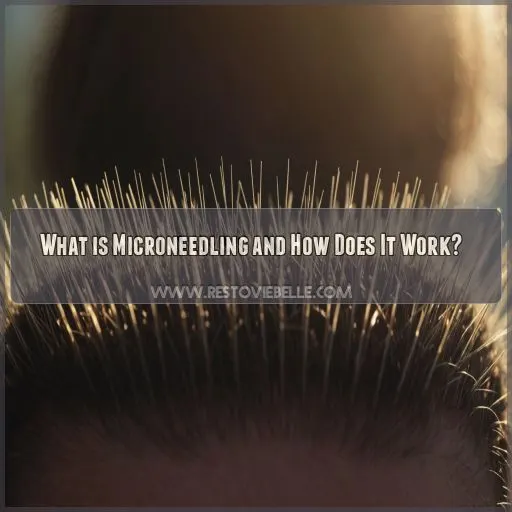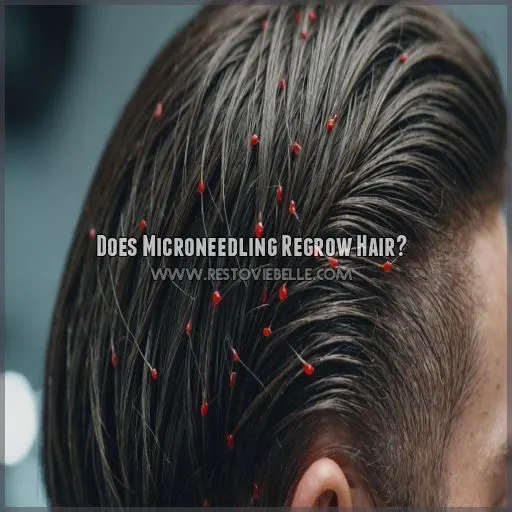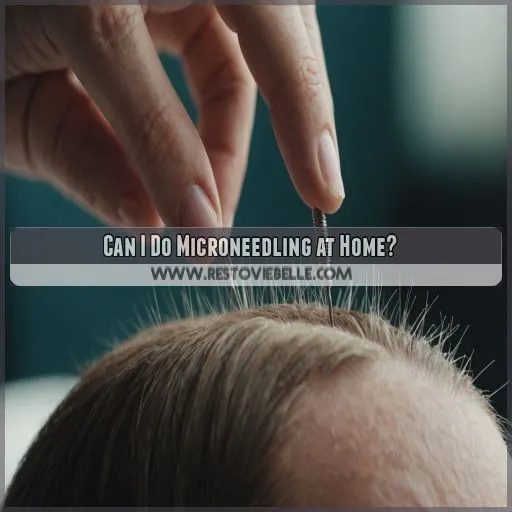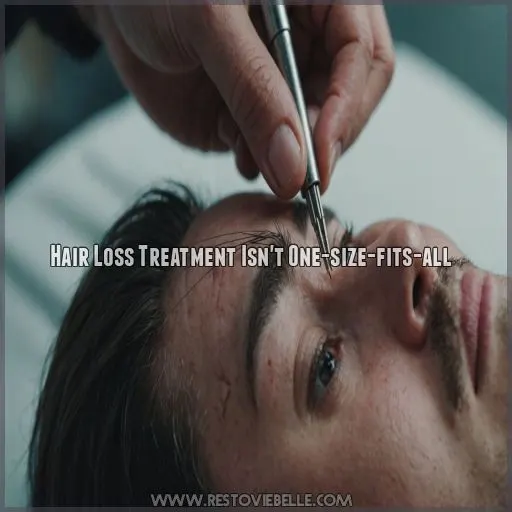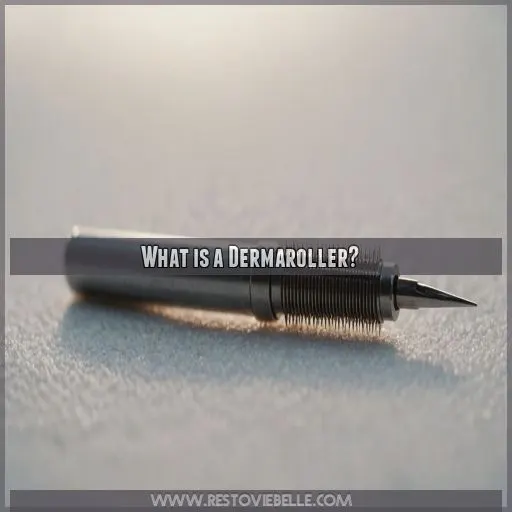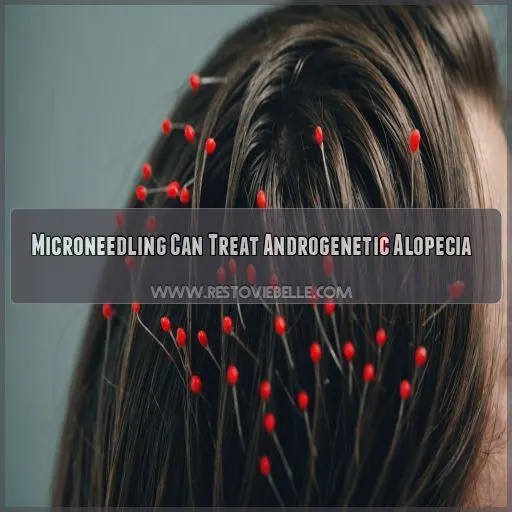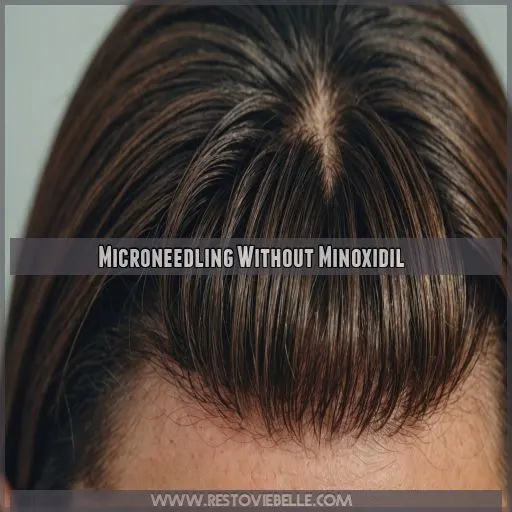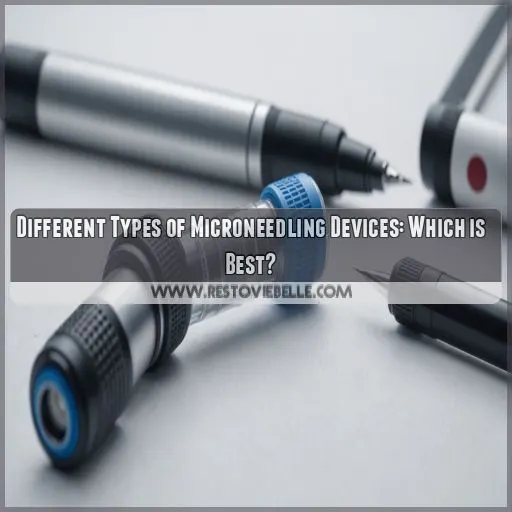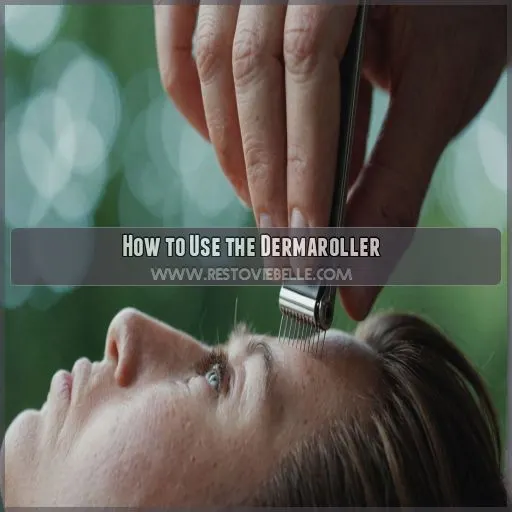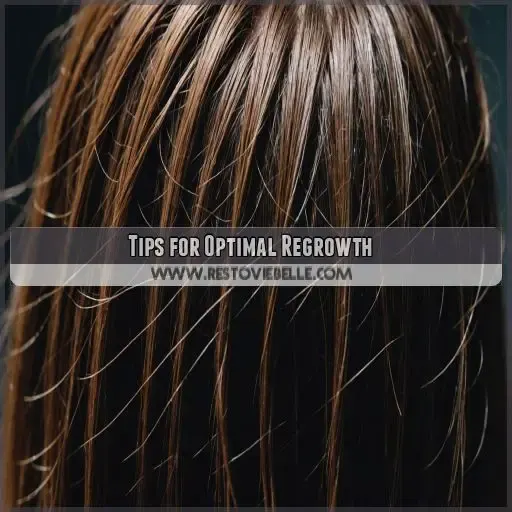This site is supported by our readers. We may earn a commission, at no cost to you, if you purchase through links.
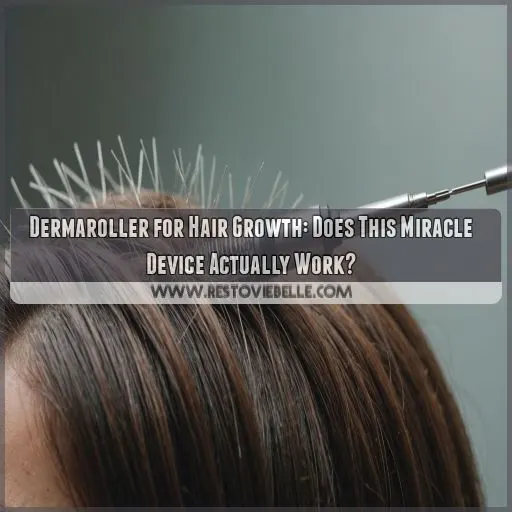
How Dermarollers Stimulate Hair Growth
When used correctly, dermarollers can indeed help stimulate your scalp and boost hair growth. The tiny needles create micro-injuries that trigger your body’s natural healing response, increasing blood flow and collagen production.
Combining Dermarollers with Other Treatments
Combined with other proven treatments like PRP therapy, a dermaroller can be a game-changer for dealing with pesky pattern baldness.
Getting Started with Dermarollers
Just remember to start with a proper diagnosis, use the right needles, and keep your scalp clean. Ready to roll your way back to a fuller head of hair?
Table Of Contents
- Key Takeaways
- What is Microneedling and How Does It Work?
- Does Microneedling Regrow Hair?
- Can I Do Microneedling at Home?
- Hair Loss Treatment Isn’t One-size-fits-all
- What is a Dermaroller?
- Microneedling Can Treat Androgenetic Alopecia
- Microneedling Without Minoxidil
- Different Types of Microneedling Devices: Which is Best?
- How to Use the Dermaroller
- Tips for Optimal Regrowth
- Frequently Asked Questions (FAQs)
- Is Dermaroller effective for hair growth?
- Is derma roller legit for hair growth?
- How often should I derma roller for hair growth?
- What size derma roller is best for hair regrowth?
- How long before I see results from microneedling?
- Can microneedling regrow hair long-term?
- Is it safe to use a dermaroller daily?
- Does microneedling work for all types of hair loss?
- How often should I replace my dermaroller?
- Conclusion
Key Takeaways
- Dermarollers can be a game-changer for your thinning locks by boosting blood flow and collagen production, but you have to use them correctly – start with a proper diagnosis and needle size, and keep that scalp squeaky clean.
- Combining dermarollers with other proven treatments like PRP therapy can supercharge your hair growth, but don’t try to tackle this at home just yet – let the professionals show you the ropes first. To learn more about hair growth treatments.
- Microneedling is the secret sauce behind dermarollers, creating micro-injuries that kickstart your body’s natural healing response and get those dormant follicles back in action.
- Patience and consistency are key – stick with a weekly dermarolling routine, and don’t be afraid to experiment with scalp massages and supplements to give your hair an extra boost.
What is Microneedling and How Does It Work?
Microneedling is a skincare treatment that uses tiny needles to create microscopic punctures in your skin.
This clever technique triggers your body’s natural healing response, ramping up collagen production and potentially stimulating hair growth on your scalp, which can be helpful for those experiencing hair loss. like microneedling.
The Mechanism of Microneedling
Microneedling creates tiny pinpricks in your skin, triggering a wound-healing response. This process is the foundation of its effectiveness.
This response boosts blood flow and collagen production, which can stimulate hair follicles and enhance topical treatment absorption.
By kick-starting this natural regenerative process, microneedling may pave the way for thicker, healthier hair growth.
It’s a simple, non-invasive technique that harnesses your body’s own healing powers.
Potential Benefits for Hair Growth
Your scalp may hold the key to fuller, thicker hair.
By triggering the skin’s natural wound-healing response, microneedling can boost blood flow and collagen production – two key elements for stimulating dormant follicles.
With the right technique, this painless procedure could breathe new life into thinning strands, reviving your crowning glory from the roots up.
Does Microneedling Regrow Hair?
If you’re plagued by thinning locks, microneedling may be the answer you’ve been seeking.
While it’s not a one-size-fits-all solution, research suggests this ingenious technique can indeed stimulate new hair growth.
Especially when combined with other proven treatments.
Start With the Correct Diagnosis
Knowing why your hair is falling out is important before thinking about microneedling. Schedule a consultation with a dermatologist to figure out what type of alopecia you’re dealing with, like androgenetic alopecia or alopecia areata.
They can give you a proper diagnosis and make sure it’s not a medical condition that’s making your hair fall out. This helps you get the right treatment.
Key Steps to Take
- Get a professional hair loss diagnosis
- Identify the root cause of your hair loss
- Discuss treatment options with your dermatologist
- Consider your medical history and current medications
- Explore different types of alopecia and their causes
Microneedling With Platelet-rich Plasma (PRP) Therapy for Hair Loss
Combining Microneedling with Platelet-Rich Plasma (PRP) Therapy could be a game-changer for your hair loss. PRP uses your own blood platelets to stimulate follicles and promote regrowth. This potent duo has shown impressive results, but be sure to work with a professional to ensure safety and efficacy.
| Benefit | Mechanism | Considerations |
|---|---|---|
| Heightened Hair Growth | Combines micro-injuries from needling with growth factors from PRP | PRP can be costly, but may provide longer-lasting results than other treatments |
| Thicker, Stronger Hair | PRP supercharges follicles with regenerative proteins and cells | Consistency is key – multiple treatments over time are typically required |
Can I Do Microneedling at Home?
Considering giving at-home microneedling a shot? Hold on there – it’s not as simple as grabbing a dermaroller and getting to work.
While it may seem tempting to try this DIY hair growth hack, improper technique can actually do more harm than good. You see, those tiny needles can easily damage delicate scalp skin if you’re not careful.
Instead, it’s best to get your first microneedling session performed by a licensed professional. They can show you the ropes and make sure you’re using the right tools and techniques.
After that, you may be able to safely continue your microneedling journey at home. Just be sure to follow all the recommended guidelines to avoid any nasty side effects. Your hair will thank you!
Hair Loss Treatment Isn’t One-size-fits-all
Not all hair loss treatments work the same way for everyone, and some, like laser therapy, can be more effective than others. The key is finding an approach that fits your unique needs.
Some people may see amazing results with microneedling, while others need a combination of therapies.
Before jumping in, it’s essential to get an expert diagnosis to understand what’s triggering your hair loss. Once you know the root cause, you can explore personalized treatment options.
Lifestyle factors like stress, nutrition, and scalp health also play a role. Work closely with your dermatologist to develop a holistic plan that addresses the full scope of your hair health.
With the right guidance, you can discover the most effective path to reviving your luscious locks.
What is a Dermaroller?
Dermarollers are handheld devices that feature tiny needles designed to create micro-injuries on the skin and scalp.
These nifty tools have been used for decades to help stimulate the skin’s natural healing process, potentially boosting hair growth in the process, much like how hair steaming can help improve blood flow to the scalp.
The History of Microneedling
Dermarollers may seem like a new trend, but they have a fascinating history dating back centuries.
A Rich History of Skin Treatments
From ancient Chinese and Egyptian skin treatments to modern cosmetic procedures, microneedling has evolved over time.
The Evolution of Dermarollers
Today, dermarollers are a trusted tool for boosting skin health and potentially regrowing hair. Let’s take a closer look at their storied past!
How Does Microneedling Work?
Microneedling, often called a dermaroller, relies on tiny needles to create micro-injuries on your skin and scalp.
This triggers the body’s natural wound-healing response, boosting collagen production and blood flow.
Microneedling Can Treat Androgenetic Alopecia
If you suffer from androgenetic alopecia, also known as male or female pattern baldness, microneedling could be your hair growth game-changer. This targeted treatment stimulates your scalp to kickstart the natural hair growth process.
The micro-injuries created by the tiny needles trigger your body’s wound-healing response, increasing blood flow and collagen production – both important for healthy, thicker hair.
- Microneedling can help revive dormant hair follicles, making it an effective option for pattern baldness.
- Unlike some medications, microneedling addresses the root cause of your hair loss, not just the symptoms.
- Combining microneedling with your current hair loss regimen could amplify your results and get you one step closer to a fuller, healthier head of hair.
Microneedling Without Minoxidil
Donning your dermaroller without minoxidil? You’re a braver soul than most! While it may seem like a shortcut, going the extra mile with a medicated treatment is often worth the effort.
Still, microneedling solo can yield impressive results, especially if you have the patience to stick with it. Just keep in mind that your experience may vary – some see a boost in hair growth, while others don’t notice much change. For example, eating a variety of fruits can help support hair growth, but individual results can vary.
The key is consistency and proper technique. Start slow, listen to your scalp, and adjust as needed. With a little trial and error, you might just find the microneedling magic you’ve been searching for.
Different Types of Microneedling Devices: Which is Best?
Microneedling devices have a lot of options.
Dermarollers, dermastamps, and dermapens all promise to stimulate hair growth, but which one is the real superstar?
Let’s explore the unique features of each device to help you choose the perfect microneedling companion for your haircare routine.
Dermaroller
The dermaroller is a tried-and-true option for microneedling devices, standing out as a top choice. This handheld tool boasts an array of tiny needles that can work wonders for your hair.
Consider the dermaroller’s versatility, affordability, and user-friendliness – it may just be the secret weapon your thinning strands have been craving.
Here are some key benefits of using a dermaroller:
- Needle length options for targeted treatment
- Easy to use at home with minimal training
- Wallet-friendly compared to professional treatments
- Clinically proven to stimulate hair growth
- Customizable for your unique hair care needs
Dermastamp
Looking to upgrade from a basic dermaroller? Consider the dermastamp – a precision microneedling tool that can reach those hard-to-target areas.
With its stamp-like motion, the dermastamp may provide more control and allow for deeper penetration.
Just be sure to start slow and follow proper technique to avoid any irritation or skin damage.
Dermapen
The Dermapen is a step up from the Dermaroller, with its automated needle movement for a more consistent and controlled treatment.
It offers deeper penetration, better precision, and reduced risk of epidermal damage.
However, the Dermapen generally costs more and requires professional administration.
For the best results, consult a dermatologist to determine the right microneedling device for your needs.
How to Use the Dermaroller
Using a dermaroller for hair growth requires proper technique and care.
To maximize the benefits of this powerful hair-boosting tool, follow the right steps.
These steps include choosing the right needle size and maintaining hygiene.
Proper Technique
When using your dermaroller, be sure to start with a clean, dry scalp.
Gently roll the device in horizontal, vertical, and diagonal motions, applying mild pressure. You don’t need to draw blood – just focus on stimulating the scalp.
Keep your hair short for easy access and better visibility of results.
Sterilize the device before each use for the best safety.
What Size Needles?
Choosing the right needle length is important for effective yet safe microneedling at home.
Opt for 1.0-1.5 mm needles, as longer lengths are better left to professionals.
Shorter needles won’t penetrate deep enough to trigger the skin’s healing response for hair growth.
Strike the perfect balance between results and safety with this handy dermaroller tip.
How Often?
You’ll want to use your dermaroller once a week for the best results. Any more frequent may cause irritation, while less often may slow progress.
Key Considerations
- Weekly treatments
- Avoid over-treating
- Maintain a schedule
- Be patient with results
Staying on Track
Aim for a consistent weekly schedule – your hair follicles will thank you! Try setting a recurring reminder on your calendar to keep you on track.
The Key to Success
The key is patience and perseverance.
Hygiene
Proper hygiene is essential when using a dermaroller.
Always sterilize the device before each use to prevent infection. This is crucial in maintaining a safe and healthy environment for your scalp.
Make sure your scalp is clean and dry – an infection can derail your progress. This is especially important, as an infection can hinder the effectiveness of the dermaroller.
Take the time to thoroughly disinfect the tool, and you’ll be well on your way to healthier, fuller hair.
Tips for Optimal Regrowth
To get the best results from your dermaroller, keep your hair short.
This will allow for a more effective treatment. Adding a relaxing scalp massage to your routine can also enhance the experience.
Combining microneedling with an oral supplement can provide total hair support. This comprehensive approach can lead to better results.
When using your dermaroller, focus on balding areas and use proper technique. If you’re unsure about how to proceed, consider consulting with your dermatologist. They can guide you through your first session and provide a solid start.
Cut Your Hair Short
Trimming your locks helps you see your scalp better, making it easy to target those balding spots. This is especially important for effective dermarolling sessions.
Shorter strands won’t get in the way during application, allowing you to glide the roller across your head with ease. This makes the process smoother and more efficient.
Maximize the effectiveness of your at-home microneedling sessions with this simple styling tip. By keeping your hair short and tidy, you can get the most out of your dermarolling routine.
Add Scalp Massage to Your Haircare Routine
While a short haircut may improve visibility, don’t forget to incorporate scalp massage into your haircare routine.
This simple act stimulates blood flow, delivering essential nutrients to your follicles.
Try using your fingertips, a massage brush, or even a vibrating massager – experiment to find what feels best.
A little TLC for your scalp can go a long way!
Combine With an Oral Supplement
Looking to amplify your dermaroller regimen? Consider pairing it with an oral hair supplement. A balanced approach can maximize your microneedling results.
There are several popular options that can provide systemic support. Saw palmetto, biotin, a key nutrient for hair health, and hair biotic are some of the most well-known supplements for hair growth.
However, be mindful of potential interactions and always check with your healthcare provider before adding new supplements.
Here’s a breakdown of the key benefits and potential risks associated with each supplement:
| Supplement | Key Benefits | Potential Risks |
|---|---|---|
| Saw Palmetto | Blocks DHT, promotes growth | Digestive issues, headaches |
| Biotin | Strengthens hair and nails | Acne, elevated blood sugar |
| Hair Biotic | Nourishes follicles, reduces shedding | None if dosed properly |
Focus on the Balding Areas, and Use Proper Technique
When microneedling, focus your dermaroller on the balding areas for the best results.
Use just enough pressure to create pinpoint bleeding – no need to bear down.
And don’t forget to incorporate scalp massage after your sessions for enhanced circulation and stimulation.
Proper technique is key to maximizing hair growth from this treatment.
Get Your First Session at a Licensed Practitioner
Getting your first microneedling session with a licensed professional is a smart move.
They’ll walk you through the proper technique, use the right needle size, and make sure your safety is top of mind.
Why risk DIY trial and error when an expert can set you up for success?
Treat yourself to a little guidance – your hair will thank you.
Common Mistakes
Avoid common pitfalls like using the wrong needle size, applying too much pressure, or ignoring proper hygiene – these can damage your scalp and undermine your results.
Proper Technique is Key
Rolling in the wrong direction or over-treating won’t give you the best outcomes either. Focus on doing it right, and you’ll be on your way to thicker, healthier hair.
Frequently Asked Questions (FAQs)
Is Dermaroller effective for hair growth?
Using a dermaroller can be like a superhero for your scalp.
It can boost collagen and blood flow for thicker, stronger locks.
Just don’t overdo it – a little goes a long way.
Is derma roller legit for hair growth?
Derma rollers can absolutely help stimulate hair growth.
The micro-needling process boosts collagen and blood flow to the scalp.
Just be sure to use them properly under a dermatologist’s guidance for best results.
How often should I derma roller for hair growth?
Once a week is the sweet spot for most folks.
Any more frequent washing and your scalp may struggle to recover.
Consistency is key if you want to see those lush locks.
What size derma roller is best for hair regrowth?
You’ll want to use a 0-5mm derma roller for best hair regrowth.
This needle length strikes the perfect balance – it’s strong enough to stimulate follicles, yet gentle enough to avoid damaging the scalp.
Give it a try once a week for best results.
How long before I see results from microneedling?
Rome wasn’t built in a day, and neither is your hair regrowth.
Hang in there, tiger – with consistent microneedling, you can expect to see results in 2-3 months, though patience is key.
Trust the process, and your mane will flourish.
Can microneedling regrow hair long-term?
Microneedling can stimulate long-term hair regrowth by boosting collagen and blood flow.
It’s essential to have realistic expectations – don’t expect overnight miracles. Instead, be prepared to invest time and effort into the process.
Consistency is key to achieving the desired results – those fuller, healthier locks you’re after.
Is it safe to use a dermaroller daily?
Daily dermarolling is a recipe for disaster.
Your scalp ain’t made of steel, y’know? It can’t handle the constant stress and pressure of daily dermarolling.
Stick to once a week, max, or you’ll end up looking like a pincushion. Trust me, your head don’t need that kind of abuse.
Does microneedling work for all types of hair loss?
While microneedling shows promise for certain hair loss types, it won’t work for all causes.
The key to effective treatment is getting an accurate diagnosis from your dermatologist to make sure you get the right treatment that targets the root issue.
How often should I replace my dermaroller?
You’ll want to replace your dermaroller every 3-6 months.
Just like your toothbrush, the needles dull over time.
75% of users report visible improvement after just 2-3 months with a fresh dermaroller – so don’t skimp on this simple, yet important step!
Conclusion
Envision yourself running your fingers through a full, lush mane – a reality you can achieve with the power of the trusty dermaroller.
This versatile device, when used correctly, can jumpstart your hair growth journey, reviving dormant follicles and stimulating new, healthy strands.
The key to regrowing your hair lies in your hands – or, more precisely, at your fingertips with the dermaroller, which can help you embrace the dermaroller’s microneedling magic.
Watch as your locks transform from thinning to thriving.

